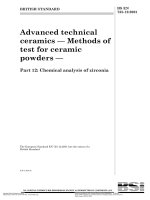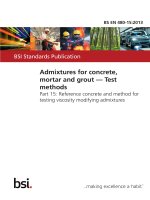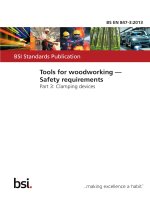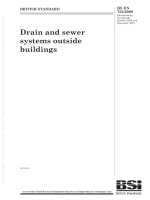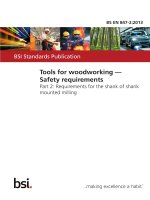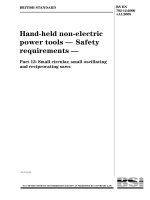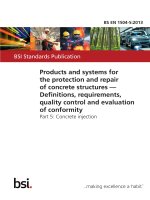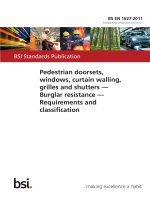Bsi bs en 61788 12 2013
Bạn đang xem bản rút gọn của tài liệu. Xem và tải ngay bản đầy đủ của tài liệu tại đây (1.23 MB, 32 trang )
BS EN 61788-12:2013
BSI Standards Publication
Superconductivity
Part 12: Matrix to superconductor
volume ratio measurement — Copper
to non-copper volume ratio of Nb3Sn
composite superconducting wires
BRITISH STANDARD
BS EN 61788-12:2013
National foreword
This British Standard is the UK implementation of EN 61788-12:2013. It is
identical to IEC 61788-12:2013. It supersedes BS EN 61788-12:2002 which is
withdrawn.
The UK participation in its preparation was entrusted to Technical
Committee L/-/90, Super Conductivity.
A list of organizations represented on this committee can be obtained on
request to its secretary.
This publication does not purport to include all the necessary provisions of
a contract. Users are responsible for its correct application.
© The British Standards Institution 2013.
Published by BSI Standards Limited 2013
ISBN 978 0 580 75669 6
ICS 29.050
Compliance with a British Standard cannot confer immunity from
legal obligations.
This British Standard was published under the authority of the
Standards Policy and Strategy Committee on 31 October 2013.
Amendments/corrigenda issued since publication
Date
Text affected
BS EN 61788-12:2013
EUROPEAN STANDARD
EN 61788-12
NORME EUROPÉENNE
October 2013
EUROPÄISCHE NORM
ICS 29.050
Supersedes EN 61788-12:2002
English version
Superconductivity Part 12: Matrix to superconductor volume ratio measurement Copper to non-copper volume ratio of Nb3Sn composite
superconducting wires
(IEC 61788-12:2013)
Supraconductivité Partie 12 : Mesure du rapport volumique
matrice/supraconducteur Rapport volumique cuivre/non-cuivre des
fils en composite supraconducteur Nb3Sn
(CEI 61788-12:2013)
Supraleitfähigkeit Teil 12: Messung des Verhältnisses von
Matrixvolumen zu Supraleitervolumen Verhältnis des Kupfervolumens
zum kupferfreien Volumen
von Nb3Sn-Verbundsupraleiterdrähten
(IEC 61788-12:2013)
This European Standard was approved by CENELEC on 2013-07-17. CENELEC members are bound to comply
with the CEN/CENELEC Internal Regulations which stipulate the conditions for giving this European Standard
the status of a national standard without any alteration.
Up-to-date lists and bibliographical references concerning such national standards may be obtained on
application to the CEN-CENELEC Management Centre or to any CENELEC member.
This European Standard exists in three official versions (English, French, German). A version in any other
language made by translation under the responsibility of a CENELEC member into its own language and notified
to the CEN-CENELEC Management Centre has the same status as the official versions.
CENELEC members are the national electrotechnical committees of Austria, Belgium, Bulgaria, Croatia, Cyprus,
the Czech Republic, Denmark, Estonia, Finland, Former Yugoslav Republic of Macedonia, France, Germany,
Greece, Hungary, Iceland, Ireland, Italy, Latvia, Lithuania, Luxembourg, Malta, the Netherlands, Norway, Poland,
Portugal, Romania, Slovakia, Slovenia, Spain, Sweden, Switzerland, Turkey and the United Kingdom.
CENELEC
European Committee for Electrotechnical Standardization
Comité Européen de Normalisation Electrotechnique
Europäisches Komitee für Elektrotechnische Normung
CEN-CENELEC Management Centre: Avenue Marnix 17, B - 1000 Brussels
© 2013 CENELEC -
All rights of exploitation in any form and by any means reserved worldwide for CENELEC members.
Ref. No. EN 61788-12:2013 E
BS EN 61788-12:2013
EN 61788-12:2013
-2-
Foreword
The text of document 90/322/FDIS, future edition 2 of IEC 61788-12, prepared by IEC/TC 90
"Superconductivity" was submitted to the IEC-CENELEC parallel vote and approved by CENELEC as
EN 61788-12:2013.
The following dates are fixed:
•
latest date by which the document has to be
implemented at national level by
publication of an identical national
standard or by endorsement
(dop)
2014-04-17
•
latest date by which the national
standards conflicting with the
document have to be withdrawn
(dow)
2016-07-17
This document supersedes EN 61788-12:2002.
EN 61788-12:2013 includes
EN 61788-12:2002:
the
following
significant
technical
changes
with
respect
to
The main revision is the addition of two new annexes, "Uncertainty considerations" (Annex H) and
"Uncertainty evaluation in the test method of the copper to non-copper volume ratio of Nb3Sn
composite superconducting wires" (Annex I).
Attention is drawn to the possibility that some of the elements of this document may be the subject of
patent rights. CENELEC [and/or CEN] shall not be held responsible for identifying any or all such
patent rights.
Endorsement notice
The text of the International Standard IEC 61788-12:2013 was approved by CENELEC as a European
Standard without any modification.
BS EN 61788-12:2013
EN 61788-12:2013
-3-
Annex ZA
(normative)
Normative references to international publications
with their corresponding European publications
The following documents, in whole or in part, are normatively referenced in this document and are
indispensable for its application. For dated references, only the edition cited applies. For undated
references, the latest edition of the referenced document (including any amendments) applies.
NOTE When an international publication has been modified by common modifications, indicated by (mod), the relevant EN/HD
applies.
Publication
Year
Title
IEC 60050
Series International Electrotechnical Vocabulary
(IEV)
IEC 61788-5
-
EN/HD
Year
-
-
Superconductivity EN 61788-5
Part 5: Matrix to superconductor volume ratio
measurement - Copper to superconductor
volume ratio of Cu/Nb-Ti composite
superconductors
-
–2–
BS EN 61788-12:2013
61788-12 © IEC:2013
CONTENTS
INTRODUCTION ..................................................................................................................... 6
1
Scope ............................................................................................................................... 7
2
Normative references ....................................................................................................... 7
3
Terms and definitions ....................................................................................................... 7
4
Principle ........................................................................................................................... 8
5
Apparatus ......................................................................................................................... 8
6
Measurement procedure ................................................................................................... 8
6.1
7
Preparation of specimen .......................................................................................... 8
6.1.1 General ....................................................................................................... 8
6.1.2 Procedures .................................................................................................. 8
6.2 Measurement .......................................................................................................... 9
6.2.1 Photo of cross-section ................................................................................. 9
6.2.2 Transfer ....................................................................................................... 9
6.2.3 Cutting......................................................................................................... 9
6.2.4 Measurement of paper mass ........................................................................ 9
6.3 Test procedure for the second specimen ................................................................. 9
6.4 Paper mass ............................................................................................................. 9
Calculation of results ........................................................................................................ 9
8
Uncertainty of the test method ........................................................................................ 10
9
Test report ...................................................................................................................... 10
9.1 Copper to non-copper volume ratio ........................................................................ 10
9.2 Identification of test specimen ............................................................................... 10
Annex A (normative) Measurement – Image processing method ......................................... 11
Annex B (normative)
Measurement – Copper mass method ................................................ 12
Annex C (normative)
Measurement method using planimeter .............................................. 13
Annex D (informative)
Specimen polishing method ............................................................. 14
Annex E (informative) Difference of the copper to non-copper volume ratio before and
after the Nb 3 Sn generation heat treatment process .............................................................. 15
Annex F (informative) Paper mass bias at copy .................................................................. 16
Annex G (informative)
Annex H (informative)
Cross-sections of Cu/Nb 3 Sn wires ................................................... 17
Uncertainty considerations ............................................................... 18
Annex I (informative) Uncertainty evaluation in the test method of the copper to
non-copper volume ratio of Nb 3 Sn composite superconducting wires.................................... 23
Figure G.1 – Cross-sections of four Cu/Nb 3 Sn wire types according to the layout of the
stabilizer ............................................................................................................................... 17
BS EN 61788-12:2013
61788-12 © IEC:2013
–3–
Table H.1 – Output signals from two nominally identical extensometers ................................ 19
Table H.2 – Mean values of two output signals ..................................................................... 19
Table H.3 – Experimental standard deviations of two output signals ..................................... 19
Table H.4 – Standard uncertainties of two output signals ...................................................... 20
Table H.5 – Coefficient of variations of two output signals .................................................... 20
–6–
BS EN 61788-12:2013
61788-12 © IEC:2013
INTRODUCTION
The copper to non-copper volume ratio of superconducting wires serves as an important
numeric value used when determining the critical current density and its stability, which are two
of the important characteristics of superconducting wires. This standard is concerned with the
standardization of the test method for the copper to non-copper volume ratio of copper stabilized
Nb 3 Sn multi-filamentary composite superconducting wires (hereinafter referred to as Cu/Nb 3 Sn
wires).
Cu/Nb 3 Sn wires can be classified into four types according to the layout of the stabilizer as
shown in Annex G: the external stabilizer type, the internal stabilizer type, the distributed
stabilizer type and the contiguous stabilizer with distributed barrier type. The test method
specified by this standard may be applicable to a type whose cross-section is of the external
stabilizer or the internal stabilizer type regardless of the production process employed.
With regard to the internal stabilizer type, the internal structure of some Cu/Nb 3 Sn wires
prevents copper from being dissolved and removed. This precludes the application of the copper
mass method, unlike with copper matrix Nb-Ti superconducting wires. New methods are
therefore needed, as detailed in the following:
•
the paper mass method, where a photo of the cross-section of the wire being measured is
traced onto tracing paper, or a copy is made of the photo using a copying machine; the paper
is then cut out into different portions to measure the mass of each piece of paper;
•
the image processing method, where the image of the photo of the cross-section is digitized
and the areas are analyzed with software;
•
the copper mass method, where the copper of the specimen is dissolved in nitric acid
solution to leave only the non-copper portion, and to measure the mass of the specimen and
the non-copper portion of specimen.
This standard is concerned with the paper mass method which is adopted more generally. As
supplementary methods, the image processing method and the copper mass method adopted
for Cu/Nb 3 Sn wires are specified in Annex A and Annex B, respectively. The method using a
planimeter is specified in Annex C. In Annex D an example of a polishing method is also
specified.
BS EN 61788-12:2013
61788-12 © IEC:2013
–7–
SUPERCONDUCTIVITY –
Part 12: Matrix to superconductor volume ratio measurement – Copper to
non-copper volume ratio of Nb3Sn composite superconducting wires
1
Scope
This part of IEC 61788 describes a test method for determining the copper to non-copper volume
ratio of Cu/Nb 3 Sn wires.
The test method given hereunder is applicable to Nb 3 Sn composite superconducting wires with
a cross-sectional area of 0,1 mm 2 to 3,0 mm 2 and a copper to non-copper volume ratio of 0,1 or
more. It does not make any reference to the filament diameter; however, it is not applicable to
those superconducting wires with their filament, Sn, Cu-Sn alloy, barrier material and other
non-copper portions dispersed in the copper matrix or those with the stabilizer dispersed.
Furthermore, the copper to non-copper volume ratio can be determined on specimens before or
after the Nb 3 Sn formation heat treatment process.
The Cu/Nb 3 Sn wire has a monolithic structure with a round or rectangular cross-section.
Though uncertainty increases, this method may be applicable to the measurement of the copper
to non-copper volume ratio of the Cu/Nb 3 Sn wires whose cross-section and copper to
non-copper volume ratio fall outside the specified ranges.
This test method may be applied to other composite superconducting wires after some
appropriate modifications.
2
Normative references
The following documents, in whole or in part, are normatively referenced in this document and
are indispensable for its application. For dated references, only the edition cited applies. For
undated references, the latest edition of the referenced document (including any amendments)
applies.
IEC 60050
(all
parts),
International
<>
Electrotechnical
Vocabulary
(available
at
IEC 61788-5, Superconductivity – Part 5: Matrix to superconductor volume ratio measurement –
Copper to superconductor volume ratio of Cu/Nb-Ti composite superconductors
3
Terms and definitions
For the purposes of this document, the terms and definitions given in IEC 60050-815 as well as
the following apply.
3.1
copper to non-copper volume ratio
ratio of the volume of the copper stabilizing material to the volume without copper consisting of
Cu/Nb 3 Sn wires
–8–
4
BS EN 61788-12:2013
61788-12 © IEC:2013
Principle
The principle of this method is described in the following. A photo of the polished cross-section
of the sample wire shall be taken with a metallograph. This photo is traced onto tracing paper, or
a copy is made of the photo using a copy machine. The tracing paper or copy is then cut out into
different portions to measure the mass of each piece of paper. The copper to non-copper volume
ratio can be obtained from the ratio of the paper mass of both portions.
5
Apparatus
The apparatus required for the test includes the following:
•
metallograph;
•
photomicrographic camera;
•
polishing machine;
•
balance;
A balance shall have a manufacturer’s specified uncertainty of ±0,1 mg or better.
•
scissors or cutter.
6
Measurement procedure
6.1
Preparation of specimen
6.1.1
General
The specimen shall be prepared from a Cu/Nb 3 Sn wire before or after the Nb 3 Sn generation
heat treatment process. Two specimens shall be cut out of a Cu/Nb 3 Sn wire being measured.
NOTE In the case of measuring an internal tin processed wire before the treatment, the stabilizer copper is carefully
distinguished from copper in other parts.
6.1.2
6.1.2.1
Procedures
Mold
The two specimens shall be molded at the same time for polishing. As the molding material, an
appropriate resin shall be used to embed the specimen for observation through the metallograph.
When molding, it shall be carefully checked that the cross-section of the specimen is at right
angles to the polishing surface as much as possible.
6.1.2.2
Polishing
The specimen shall be polished using emery paper and buffed using an abrasive material. A
microscope shall be used to check that the polished surface is smooth enough to ensure good
photographing, especially the boundary between the copper and non-copper portions and the
periphery of the sample. The surface shall be re-polished, if these areas are not clear because
of abrasive scratches. An example of the polishing method is specified in Annex D.
6.1.2.3
Cleaning and drying
The polished specimen shall be cleaned using running water, distilled water, acetone or ethyl
alcohol. It shall be checked that the cleaning agent does not dissolve the resin in which the
specimen is embedded. An ultrasonic cleaning machine may be used if necessary. After
cleaning, the specimen shall be dried with chilled or hot air to prevent the polished surface from
oxidizing or discoloring.
BS EN 61788-12:2013
61788-12 © IEC:2013
6.2
–9–
Measurement
6.2.1
Photo of cross-section
A black-and-white or color picture of the cross-section shall be taken using the metallograph.
The magnification shall be selected for the entire cross-section of the specimen to fit within the
size of the photo. A photomicrographic camera with as much depth of focus as possible shall be
used, so that the boundary between copper and non-copper portions and the periphery of the
specimen appear clear and vivid on the photo.
6.2.2
Transfer
The image of the cross-section shall be traced on tracing paper so that the copper portion and
non-copper portion can be separated.
As an alternative method, a copy of the photo of the cross-section shall be made using a copying
machine. A zoom ratio of the copier that will fit the image in a sheet of paper and allow the cutting
work to be done easily shall be selected. If a copy is to be made using a copy machine, a copy
of a scale shall be made at the same time, to check that the copier distortion is within ±1 % (see
Annex F).
6.2.3
Cutting
Scissors or a cutter shall be used to cut the tracing paper or the copy into the copper and
non-copper portions.
6.2.4
Measurement of paper mass
The first specimen shall be measured twice.
The paper mass of the copper portion and non-copper portion shall be measured with a
combined standard uncertainty not to exceed 0,1 mg. Each portion shall be measured twice and
the average of the two measurements shall be reported.
During the measurement, caution shall be taken to ensure that the measurement is not affected
by humidity. If the mass continues to change, the specimen shall remain in the measurement
chamber for about 10 min before resuming the measurement sequence.
6.3
Test procedure for the second specimen
The steps given under 6.2 shall be repeated to measure the paper mass for the second
specimen.
6.4
Paper mass
The paper mass of the copper portion (M Cu ) to that of the non-copper portion (M non ) shall be
obtained by averaging the paper mass measured at steps 6.2 and 6.3.
7
Calculation of results
For each measurement taken in 6.2 and 6.3, the copper to non-copper volume ratio shall be
obtained from the ratio of the paper mass of the copper portion to that of the non-copper portion.
Copper to non-copper volume ratio is expressed as M Cu /M non
The ratio shall be rounded to two decimal places.
– 10 –
8
BS EN 61788-12:2013
61788-12 © IEC:2013
Uncertainty of the test method
The uncertainty of this test method is affected by the sag of the specimen occurring from
polishing, transfer to tracing paper, distortion of the copying machine and uncertainty in cutting
out portions from the paper. The relative combined standard uncertainty of this method shall not
exceed 2,5 %(using a coverage factor of k = 1) as shown in Clause I.1.
9
9.1
Test report
Copper to non-copper volume ratio
The report shall contain the following information:
a) copper to non-copper volume ratio of each specimen;
b) wire diameter or size of the cross-section if it is a rectangular shape;
c) whether the specimens had or had not received the Nb 3 Sn generation heat treatment.
The report shall contain the following information if known:
d) manufacturing method;
e) configuration of the copper matrix;
f)
photo of cross-section;
g) measurement conditions and information;
h) raw measured data;
i)
9.2
information of measurement equipment.
Identification of test specimen
The test specimen shall be identified by the following information if known:
a) name of the manufacturer of the specimen;
b) identification number;
c) billet number.
BS EN 61788-12:2013
61788-12 © IEC:2013
– 11 –
Annex A
(normative)
Measurement – Image processing method
A.1
Method
The following details describe the method that can be used to digitize the image on the
cross-sectional photo (image processing method).
a) Following the steps from 6.1 through 6.2.1, photos of the cross-section of the specimens
shall be taken.
b) Using a scanner, the image of the cross-section photos shall be captured in a personal
computer.
c) Using image analysis software, the number of pixels on the copper portion and non-copper
portion shall be determined.
d) The copper to non-copper volume ratio of the specimen shall be determined using the
following equation:
R Cu,i =
N Cu
N non
(A.1)
where
R Cu,i is the copper to non-copper volume ratio with image processing method;
N Cu
is the number of pixels on the copper portion;
N non
is the number of pixels on the non-copper portion.
A.2
Test report
The following information shall be reported in addition to the data listed in Clause 9: image
analysis software used.
NOTE 1 Measurement uncertainty of the image processing method is determined by the quality of image of the photo
of cross-section. What is necessary to ensure a given level of uncertainty is taking a clear image of the specimen
cross-section with a well-polished condition.
NOTE 2 Reproducibility of the measurements taken through the image processing method applied to the image
captured from the same position at the same magnification is estimated by a relative combined standard uncertainty
not to exceed 5 %.
– 12 –
BS EN 61788-12:2013
61788-12 © IEC:2013
Annex B
(normative)
Measurement – Copper mass method
B.1
Method
The following describes the application of the copper mass method (see IEC 61788-5), which is
employed for measuring the copper to superconductor volume ratio of Nb-Ti superconducting
wires, to Nb 3 Sn. This method can be applied only to the external stabilizer type Cu/Nb 3 Sn wire
with a round cross-section that exhibits a nature whereby copper dissolves in nitric acid.
Nevertheless, it shall be avoided to apply this method to such wires if they have barriers that can
be broken in the process of dissolving by nitric acid.
a) A specimen with a length of 300 mm to 500 mm shall be cut and the mass (M1 ), length (L)
and diameter (D) of the specimen shall be determined. The diameter shall be measured at
five equally divided points and, taking the average of the measurements, the volume (V 1 )
shall be calculated:
V 1 = π(D/2) 2 L
(B.1)
b) The copper of the specimen shall be dissolved in nitric acid solution completely to leave only
the non-copper portion. At this time, the specimen shall be rinsed quickly with water once the
copper has dissolved, thereby minimizing the amount of bronze dissolved.
c) The specimen shall be dried completely after rinsing.
d) The mass (M 2 ) of non-copper portion shall be measured.
e) The volume (V 2 ) of the copper portion shall be calculated using 8,93 g/cm 3 as the specific
mass of copper.
V 2 = (M 1 –M 2 ) / 8,93
f)
(B.2)
The copper to non-copper volume ratio with copper mass method (R Cu,c ) shall be calculated
from the volume (V 1 ) of the specimen and volume (V 2 ) of the copper portion.
R Cu,c = V 2 / (V 1 –V 2 )
(B.3)
g) The relative combined standard uncertainty of this method shall not exceed 2,5%(using a
coverage factor of k = 1) as shown in Clause I.3.
B.2
Test report
The following information shall be reported in addition to the data listed in Clause 9: the
necessary information according to the test report in IEC 61788-5.
BS EN 61788-12:2013
61788-12 © IEC:2013
– 13 –
Annex C
(normative)
Measurement method using planimeter
C.1
Method
The following details describe the method using an analogue or a digital planimeter.
a) According to steps 6.1 to 6.2.1, a photo of the cross-section shall be taken.
b) A copy of the photo of the cross-section shall be made using a copying machine. A zoom
ratio of the copier shall be selected so that the size of the enlarged image is more than
120 mm in width and within a sheet of paper.
c) The values of cross-sections for copper and non-copper parts shall be obtained using a
planimeter. Measurement with 5 turns of the planimeter to integrate the area is
recommended in order to reduce the uncertainty. The measurement shall be carried out
twice for the same photo, and the average value shall be the cross-sectional area if the
measured values are within 5 %. If this value is more than 5 %, the measurement shall be
carried out again.
NOTE In the case of relative combined standard uncertainty of a planimeter within 0,5 %, either an analog or a
digital planimeter apparatus can be used.
d) In the case of an external stabilizer type, the cross-sectional area of the copper part shall be
obtained by subtracting that of the non-copper part from the whole area of the specimen. In
the case of an internal stabilizer type, the cross-sectional area of the non-copper part shall
be obtained by subtracting that of the copper part from the whole area.
C.2
Test report
The following information shall be reported in addition to the data listed in Clause 9: type of
planimeter and zoom ratio of the copy used.
– 14 –
BS EN 61788-12:2013
61788-12 © IEC:2013
Annex D
(informative)
Specimen polishing method
D.1
General
In the method used to find the copper to non-copper volume ratio from the photo of the
cross-section, it is extremely important to perform good polishing so that a clear photo of the
cross-section can be taken. For reference, here are typical procedures for polishing
the specimen.
D.2
Polishing with emery paper
The purpose of this polishing process is to make the polishing surface of the specimen
embedded in resin flat for observation through the metallograph. The grain size of the emery
paper may be omitted; however, polishing is to be done proceeding from coarse to fine grain,
Nos.120, 180, 400, 600, 800, 1 000, 1 200, 1 500, and 2 400. To obtain the required flatness of
the polishing surface, apply a uniform force to the surface in one direction only. Whenever the
grain sizes are changed, polish in the direction at right angles to the preceding one and proceed
with the next grain size only after traces of the preceding polishing have been eliminated.
D.3
Buffing
This polishing process is of a wet type, employing a buffing pad, Al 2 O 3 (alumina), SiO 2 and
diamond abrasives. The best possible conditions for this process are for the abrasive materials
to be spread evenly over the buffing pad and the buffing pad to be uniformly damp. The
specimen must be turned during buffing to prevent the surface from being polished in one
direction only. This ensures a uniformly polished surface. An excessively long buffing operation
can cause the wire periphery to sag.
If sag and noticeable scratches are evident on the polished surface through microscopic
observation, re-polish it, starting with emery paper of an appropriate grain size.
D.4
Cleaning and drying
The polished specimen is to be cleaned using running water, distilled water, acetone, or ethyl
alcohol. Check that the cleaning agent does not dissolve the resin in which the specimen is
embedded. An ultrasonic cleaning machine may be used if necessary. After cleaning, let the
specimen dry with chilled or hot air to prevent the polished surface from oxidizing or discoloring.
BS EN 61788-12:2013
61788-12 © IEC:2013
– 15 –
Annex E
(informative)
Difference of the copper to non-copper volume ratio
before and after the Nb 3Sn generation heat treatment process
The difference of the copper to non-copper volume ratio before and after the Nb 3 Sn generation
heat treatment process is within ±2 %.
– 16 –
BS EN 61788-12:2013
61788-12 © IEC:2013
Annex F
(informative)
Paper mass bias at copy
F.1
Paper mass bias caused by hue
Based on a comparison of the mass per unit area of black and white areas, it is expected that the
bias caused by the hue of the photocopy does not exceed 2 %. The bias in the practical
measurement can be estimated as less than that because the hues of the copper and
non-copper portions are closer than black and white.
F.2
Example enlarging photocopy to reduce the uncertainty
When a photo of a specimen whose diameter is 0,7 mm and copper to non-copper volume ratio
is 0,26 is taken with a magnification of 100 by a metallograph and is enlarged twice with a
photocopy machine, the paper mass of the copper and non-copper portions are 0,10 g and
0,38 g, respectively. The size of the enlarged photocopy is appropriate not only for cutting out,
but also for keeping its mass measurement bias low.
BS EN 61788-12:2013
61788-12 © IEC:2013
– 17 –
Annex G
(informative)
Cross-sections of Cu/Nb3Sn wires
Figure G.1 shows cross-sections of four Cu/Nb 3 Sn wire types according to the layout of the
stabilizer: (a) the external stabilizer type, (b) the internal stabilizer type, (c) the distributed
stabilizer type and (d) the contiguous stabilizer with distributed barrier type.
Nb 3 Sn filament
Nb 3 Sn filament
Bronze
Bronze
Barrier
Barrier
Cu stabilizer
Cu stabilizer
IEC
IEC
1605/02
(a)External stabilizer type
(b)Internal stabilizer type
Nb 3 Sn filament
Nb 3 Sn filament
Sn alloy
Bronze
Barrier
Barrier
Cu stabilizer
Cu stabilizer
IEC
1606/02
IEC
1607/02
(c)Distributed stabilizer type
1608/02
(d)Contiguous stabilizer with
distributed barrier type
Figure G.1 – Cross-sections of four Cu/Nb 3 Sn
wire types according to the layout of the stabilizer
– 18 –
BS EN 61788-12:2013
61788-12 © IEC:2013
Annex H
(informative)
Uncertainty considerations
H.1
Overview
In 1995, a number of international standards organizations, including IEC, decided to unify the
use of statistical terms in their standards. It was decided to use the word “uncertainty” for all
quantitative (associated with a number) statistical expressions and eliminate the quantitative
use of “precision” and “accuracy.” The words “accuracy” and “precision” could still be used
qualitatively. The terminology and methods of uncertainty evaluation are standardized in the
Guide to the Expression of Uncertainty in Measurement (GUM) [1] 1.
It was left to each TC to decide if they were going to change existing and future standards to be
consistent with the new unified approach. Such change is not easy and creates additional
confusion, especially for those who are not familiar with statistics and the term uncertainty. At
the June 2006 TC 90 meeting in Kyoto, it was decided to implement these changes in future
standards.
Converting “accuracy” and “precision” numbers to the equivalent “uncertainty” numbers requires
knowledge about the origins of the numbers. The coverage factor of the original number may
have been 1, 2, 3, or some other number. A manufacturer’s specification that can sometimes be
described by a rectangular distribution will lead to a conversion number of 1√3. The appropriate
coverage factor was used when converting the original number to the equivalent standard
uncertainty. The conversion process is not something that the user of the standard needs to
address for compliance to TC 90 standards, it is only explained here to inform the user about
how the numbers were changed in this process. The process of converting to uncertainty
terminology does not alter the user’s need to evaluate their measurement uncertainty to
determine if the criteria of the standard are met.
The procedures outlined in TC 90 measurement standards were designed to limit the uncertainty
of any quantity that could influence the measurement, based on the Convener’s engineering
judgment and propagation of error analysis. Where possible, the standards have simple limits
for the influence of some quantities so that the user is not required to evaluate the uncertainty of
such quantities. The overall uncertainty of a standard was then confirmed by an interlaboratory
comparison.
H.2
Definitions
Statistical definitions can be found in three sources: the GUM, the International Vocabulary of
Basic and General Terms in Metrology (VIM)[2], and the NIST Guidelines for Evaluating and
Expressing the Uncertainty of NIST Measurement Results (NIST)[3]. Not all statistical terms
used in this standard are explicitly defined in the GUM. For example, the terms “relative standard
uncertainty” and “relative combined standard uncertainty” are used in the GUM (5.1.6, Annex J),
but they are not formally defined in the GUM (see [3]).
H.3
Consideration of the uncertainty concept
Statistical evaluations in the past frequently used the coefficient of variation (COV) which is the
ratio of the standard deviation and the mean (N.B. the COV is often called the relative standard
deviation). Such evaluations have been used to assess the precision of the measurements and
give the closeness of repeated tests. The standard uncertainty (SU) depends more on the
___________
1
Figures in square brackets refer to the reference documents in Clause H.5 of this Annex.
BS EN 61788-12:2013
61788-12 © IEC:2013
– 19 –
number of repeated tests and less on the mean than the COV and therefore in some cases gives
a more realistic picture of the data scatter and test judgment.
The example below shows a set of electronic drift and creep voltage measurements from two
nominally identical extensometers using the same signal conditioner and data acquisition
system. The n = 10 data pairs are taken randomly from the spreadsheet of 32 000 cells. Here,
extensometer number one (E 1 ) is at zero offset position whilst extensometer number two (E 2 ) is
deflected to 1 mm. The output signals are in volts.
Table H.1 – Output signals from two nominally identical extensometers
Output signal
V
E1
E2
0,001 220 70
2,334 594 73
0,000 610 35
2,334 289 55
0,001 525 88
2,334 289 55
0,001 220 70
2,334 594 73
0,001 525 88
2,334 594 73
0,001 220 70
2,333 984 38
0,001 525 88
2,334 289 55
0,000 915 53
2,334 289 55
0,000 915 53
2,334 594 73
0,001 220 70
2,334 594 73
Table H.2 – Mean values of two output signals
Mean (
V
X
)
E1
E2
0,001 190 19
2,334 411 62
n
X =
∑ Xi
i =1
V
n
(H.1)
Table H.3 – Experimental standard deviations of two output signals
Experimental standard deviation (s)
V
E1
E2
0,000 303 48
0,000 213 381
s=
n
1
⋅ ∑ Xi − X
n − 1 i =1
(
)2
V
(H.2)
BS EN 61788-12:2013
61788-12 © IEC:2013
– 20 –
Table H.4 – Standard uncertainties of two output signals
Standard uncertainty (u)
V
E1
E2
0,000 095 97
0,000 067 48
u=
s
V
n
(H.3)
Table H.5 – Coefficient of variations of two output signals
Coefficient of Variation (COV)
%
E1
E2
25,4982
0,0091
COV =
s
X
(H.4)
The standard uncertainty is very similar for the two extensometer deflections. In contrast the
coefficient of variation COV is nearly a factor of 2 800 different between the two data sets. This
shows the advantage of using the standard uncertainty which is independent of the mean value.
H.4
Uncertainty evaluation example for TC 90 standards
The observed value of a measurement does not usually coincide with the true value of the
measurand. The observed value may be considered as an estimate of the true value. The
uncertainty is part of the "measurement error" which is an intrinsic part of any measurement. The
magnitude of the uncertainty is both a measure of the metrological quality of the measurements
and improves the knowledge about the measurement procedure. The result of any physical
measurement consists of two parts: an estimate of the true value of the measurand and the
uncertainty of this “best” estimate. The GUM, within this context, is a guide for a transparent,
standardized documentation of the measurement procedure. One can attempt to measure the
true value by measuring “the best estimate” and using uncertainty evaluations which can be
considered as two types: Type A uncertainties (repeated measurements in the laboratory in
general expressed in the form of Gaussian distributions) and Type B uncertainties (previous
experiments, literature data, manufacturer’s information, etc. often provided in the form of
rectangular distributions).
The calculation of uncertainty using the GUM procedure is illustrated in the following example:
a) The user must derive in the first step a mathematical measurement model in the form of
identified measurand as a function of all input quantities. A simple example of such model
is given for the uncertainty of a force, F LC measurement using a load cell:
F LC = W + d w + d R
+ d Re
Where W, d w , d R , and d Re represent the weight of standard as expected, the manufacturer’s
data, repeated checks of standard weight/day and the reproducibility of checks at different
days, respectively.
Here the input quantities are: the measured weight of standard weights using different
balances (Type A), manufacturer’s data (Type B), repeated test results using the digital
electronic system (Type B), and reproducibility of the final values measured on different days
(Type B).
BS EN 61788-12:2013
61788-12 © IEC:2013
– 21 –
b) The user should identify the type of distribution for each input quantity (e.g. Gaussian
distributions for Type A measurements and rectangular distributions for Type B
measurements).
c) Evaluate the standard uncertainty of the Type A measurements,
s
where, s is the experimental standard deviation and n is the total number of
n
measured data points.
uA =
d) Evaluate the standard uncertainties of the Type B measurements:
uB =
1
⋅ d w 2 + ....... where, d w is the range of rectangular distributed values
3
e) Calculate the combined standard uncertainty for the measurand by combining all the
standard uncertainties using the expression:
2
uc = u A
+ uB2
In this case, it has been assumed that there is no correlation between input quantities. If the
model equation has terms with products or quotients, the combined standard uncertainty is
evaluated using partial derivatives and the relationship becomes more complex due to the
sensitivity coefficients [4], [5].
f)
Optional – the combined standard uncertainty of the estimate of the referred measurand can
be multiplied by a coverage factor (e. g. 1 for 68 % or 2 for 95 % or 3 for 99 %) to increase
the probability that the measurand can be expected to lie within the interval.
g) Report the result as the estimate of the measurand ± the expanded uncertainty, together
with the unit of measurement, and, at a minimum, state the coverage factor used to compute
the expanded uncertainty and the estimated coverage probability.
To facilitate the computation and standardize the procedure, use of appropriate certified
commercial software is a straightforward method that reduces the amount of routine work [6], [7].
In particular, the indicated partial derivatives can be easily obtained when such a software tool
is used. Further references for the guidelines of measurement uncertainties are given in [3], [8],
and [9].
H.5
Reference documents of Annex H
[1]
ISO/IEC Guide 98-3:2008, Uncertainty of measurement – Part 3: Guide to the expression
of uncertainty in measurement (GUM 1995)
[2]
ISO/IEC Guide 99:2007, International vocabulary of metrology – Basic and general
concepts and associated terms (VIM)
[3]
TAYLOR, B.N. and KUYATT, C.E. Guidelines for Evaluating and Expressing the
Uncertainty of NIST Measurement Results. NIST Technical Note 1297, 1994 (Available
at < />
[4]
KRAGTEN, J.Calculating standard deviations and confidence intervals with a universally
applicable spreadsheet technique. Analyst, (1994), 119, 2161-2166
[5]
EURACHEM / CITAC Guide CG 4 Second edition:2000, Quantifying Uncertainty in
Analytical Measurement
[6]
[Cited 2013-03-07] Available at < />
[7]
[Cited 2013-03-07] Available at < />
– 22 –
BS EN 61788-12:2013
61788-12 © IEC:2013
[8]
CHURCHILL, E., HARRY, H.K., and COLLE,R., Expression of the Uncertainties of Final
Measurement Results. NBS Special Publication 644 (1983)
[9]
JAB NOTE Edition 1:2003, Estimation of Measurement Uncertainty (Electrical Testing /
High Power Testing).(Available at <>)
BS EN 61788-12:2013
61788-12 © IEC:2013
– 23 –
Annex I
(informative)
Uncertainty evaluation in the test method of the copper to
non-copper volume ratio of Nb3Sn composite superconducting wires
I.1
Paper mass method
I.1.1
Mathematical model
The copper to non-copper volume ratio of Nb 3 Sn composite superconducting wires measured
with the paper mass method is formally given by Equation (I.1),
R Cu,p =
M Cu
M non
(I.1)
where
R Cu,p
is the copper to non-copper volume ratio with paper mass method;
M Cu
is the average paper mass of the copper portion g;
M non
is the average paper mass of the non-copper portion g.
I.1.2
Evaluation of sensitivity coefficients
The combined standard uncertainty of the copper to non-copper volume ratio of Nb 3 Sn
composite superconducting wires with paper mass method (u RCuc,p ) is formally given by
Equation (I.2),
uRCuc,p = c12uMCu2 + c22uMnon2
(I.2)
where
u RCuc,p is a combined standard uncertainty of the copper to non-copper volume ratio with
paper mass method;
M Cu
is given by 2,50 g;
M non
is given by 1,60 g;
c1 =
c2 =
∂RCu,p
∂MCu
∂RCu,p
∂Mnon
=
1
Mnon
=−
= 0,625
MCu
Mnon2
= 0,977
1/g
1/g
Quantities used in this evaluation of sensitivity coefficients only apply to a specific experimental
case. These coefficients are not universally applicable and will be different for each experiment.
I.1.3
I.1.3.1
Combined standard uncertainty of each variable
Combined standard uncertainty of the average paper mass of the copper
portion
a) Combined standard uncertainty of photos, u photo,Cu = 0,017 g, which is composed of the
experimental standard uncertainty due to polishing specimens, 0,012 g, and the
experimental standard uncertainty due to taking photos, 0,012 g.
